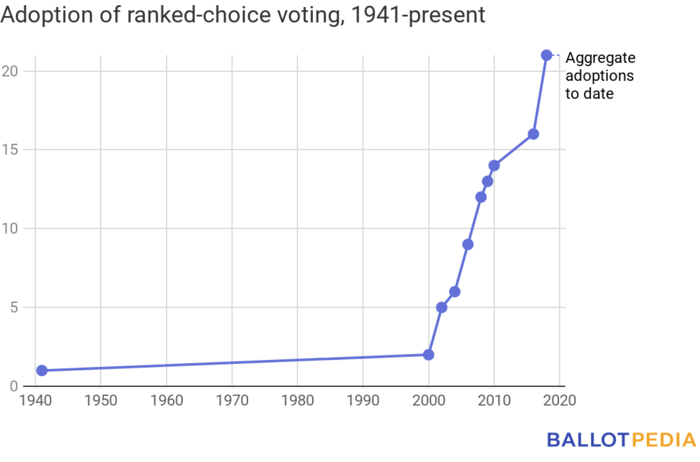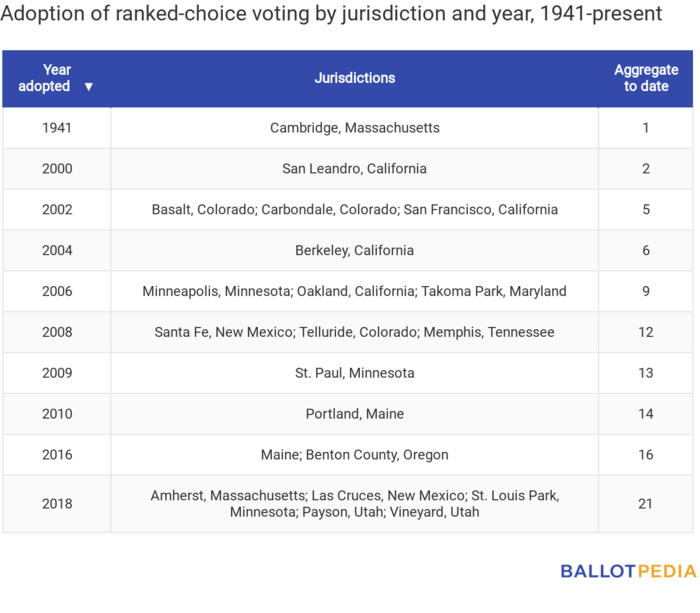The Ballot Bulletin: May 2019
Welcome to The Ballot Bulletin, where we track developments in election policy at the federal, state, and local levels. Each issue includes an in-depth feature—such as an interview or legislative analysis—and discussions of recent events relating to electoral and primary systems, redistricting, and voting provisions. In this month’s edition, we bring you up to speed on recent developments involving redistricting and ranked-choice voting.
Have a question/feedback/or just want to say hello? Respond to this email, or drop me a line directly at Jerrick@Ballotpedia.org.
Federal courts in Michigan, Ohio strike down district plans as unconstitutional partisan gerrymanders
In the last few weeks, federal courts in Michigan and Ohio struck down district plans as unconstitutional partisan gerrymanders. Let’s recap the two cases and see how we got here.
Michigan: On April 25, 2019, a three-judge panel of the U.S. District Court for the Eastern District of Michigan ruled unanimously that 9 congressional and 25 state legislative districts had been subject to unconstitutional partisan gerrymandering, violating Democrats’ First Amendment associational rights. The court also found that 27 of the 34 challenged districts violated the Democrats’ First and Fourteenth Amendment rights by diluting the impact of their votes.
The panel, comprising Judges Eric Clay (appointed by Democrat Bill Clinton), Denise Hood (a Clinton appointee), and Gordon Quist (appointed by Republican George H. W. Bush), enjoined the use of any challenged districts in future elections.
The court also ordered that special elections be conducted in 2020 for the challenged state Senate districts and any adjoining districts whose boundaries might be affected by remedial maps. The court directed the state legislature to adopt remedial maps for the challenged districts on or before August 1, 2019. The challenged districts are as follows:
- Congressional districts 1, 4, 5, 7, 8, 9, 10, 11, and 12
- State Senate districts 8, 10, 11, 12, 14, 18, 22, 27, 32, and 36
- State House districts 24, 32, 51, 52, 55, 60, 62, 63, 75, 76, 83, 91, 92, 94, and 95
- Regular U.S. House and state House elections will take place in 2020. Regular state Senate elections will not take place in 2020.
Ohio: On May 3, 2019, a three-judge panel of the U.S. District Court for the Southern District of Ohio ruled unanimously that Ohio's congressional district plan had been subject to illegal partisan gerrymandering. The court held that the plan, enacted in 2011 by a Republican legislature and governor, violated the First and Fourteenth Amendment rights of Democrats. The ruling applied to all 16 of the state's congressional districts. The panel, comprising Judges Karen Moore (appointed by Democrat Bill Clinton), Timothy Black (appointed by Democrat Barack Obama), and Michael Watson (appointed by Republican George W. Bush), enjoined the state from conducting any future congressional elections under the 2011 plan. The court ordered the state to enact a remedial plan by June 14, 2019. Should the state fail to meet this deadline, or should the state's remedial plan fail to meet the approval of the court, the court may appoint a special master to draft a remedial plan.
What is partisan gerrymandering? The phrase partisan gerrymandering refers to the practice of drawing electoral district maps with the intention of favoring one political party over another. In contrast with racial gerrymandering, on which issue the U.S. Supreme Court has made rulings in the past affirming that such practices violate federal law, the high court has not, to date, made a ruling establishing clear precedent on the question of partisan gerrymandering. Two partisan gerrymandering cases – Rucho v. Common Cause and Benisek v. Lamone – are pending before the high court this term. Rulings are expected by the end of June.
Ranked-choice voting round-up: developments in Hawaii, Utah, and New Mexico
Ranked-choice voting (RCV) proposals are moving forward in Hawaii, Utah, and New Mexico.
Hawaii: On April 9, 2019, the Hawaii House of Representatives approved its version of SB427, which, if enacted, would establish RCV for special elections held to fill federal and county-level vacancies. The bill originated in the Hawaii State Senate, which approved its original version on March 5, 2019. A conference committee has been convened to reconcile differences between the two measures. Should the conference committee report be adopted by both chambers, the bill will be delivered to Governor David Ige (D) for his action.
Utah: Two Utah cities, Payson and Vineyard, will implement RCV in this year's municipal elections. Payson and Vineyard are participating in a pilot program that allows municipalities in Utah to experiment with RCV in their municipal elections. The legislation authorizing the pilot, HB35, was sponsored by state Representatives Marc Roberts (R) and Rebecca Chavez-Houck (D). Four other cities that had expressed interest in participating in the pilot opted not to do so: West Jordan, Cottonwood Heights, Lehi, and Salem. As of 2017, the estimated populations of Payson and Vineyard were 19,647 and 2,958, respectively.
New Mexico: On April 8, 2019, the Finance and Government Committee of the Albuquerque City Council considered an ordinance to adopt RCV for municipal elections. The committee voted unanimously to postpone the matter to the committee's May 13 meeting. Two other New Mexico cities, Las Cruces and Santa Fe, have adopted RCV for municipal elections.
About RCV: A ranked-choice voting system (RCV) is an electoral system in which voters rank candidates by preference on their ballots. If a candidate wins a majority of first-preference votes, he or she is declared the winner. If no candidate wins a majority of first-preference votes, the candidate with the fewest first-preference votes is eliminated. First-preference votes cast for the failed candidate are eliminated, lifting the second-preference choices indicated on those ballots. A new tally is conducted to determine whether any candidate has won a majority of the adjusted votes. The process is repeated until a candidate wins an outright majority. This system is sometimes referred to as an instant runoff voting system.
The line chart and table below detail years during which jurisdictions have adopted RCV from 1940 to present.
Legislation update: Redistricting, electoral systems, and primary systems bills
The maps below identify states in which redistricting, electoral systems, and primary systems bills are being considered in 2019. A darker shade of red indicates a greater number of relevant bills.
See also
- Election policy on Ballotpedia
- Electoral systems legislation at the state and city levels in the United States, 2019
- Primary systems legislation at the state and city levels in the United States, 2019
- Redistricting legislation at the state and city levels in the United States, 2019
| |||||||||||||||||||||||








